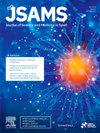在训练有素的女性在炎热条件下间歇性跑步机足球模拟中,FIFA冷却中断热政策的有效性。
IF 3
2区 医学
Q1 SPORT SCIENCES
引用次数: 0
摘要
目的:研究当前国际足联冷却中断热政策对替代冷却配置在减少生理应变在热足球模拟期间的功效。设计:在40 °C和41 %相对湿度(32 °C湿球温度)下进行5项随机平衡试验。方法:12名女性(年龄为25岁 ± 5 y, V²o2峰值为51 ± 5 mL·kg-1·min-1)完成了5次90分钟的足球模拟,并采用不同的冷却配置:常规比赛不冷却休息(REG),休息3分钟不冷却(BRKcool),休息3分钟冷却(BRKcool:国际足联现行政策;冷冻液体和冰毛巾穿过脖子/肩膀),延长中场时间5分钟,不休息(ExtHTonly),延长中场时间5分钟,休息时间3分钟(ExtHTcool)。记录直肠(Tre)和皮肤温度(Tsk)、心率、全身出汗率(WBSR)和感知运动评分(RPE)。数据以平均值和95% %置信区间[CI]表示。ExtHTcool结果:最后的混乱关系较低(38.4 °C [38.1, 38.7], P 只( 38.7°C (38.4, 39.0), P = 0.003)和BRKno-cool( 38.7°C (38.4, 39.0), P = 0.006),而在BRKcool相似和注册(P = 0.062)。ExtHTcool组的平均心率低于REG组(3次·min-1 [2,4], P 0.133),RPE低于REG组(0.6 [0.3,0.9],P cool组(0.2 [-0.0,0.5],P = 0.089)。结论:国际足联热政策提供最小的生理或知觉上的好处,女性在高温下进行足球模拟。然而,将冷却休息与延长中场休息相结合,这不是目前国际足联的散热政策的一部分,可以减轻热量和心血管压力。本文章由计算机程序翻译,如有差异,请以英文原文为准。
Efficacy of the FIFA cooling break heat policy during an intermittent treadmill football simulation in hot conditions in trained females
Objectives
To investigate the efficacy of the current FIFA cooling break heat policy against alternative cooling configurations in attenuating physiological strain during a football simulation in the heat.
Design
Five randomised counterbalanced experimental trials in 40 °C and 41 % relative humidity (32 °C wet-bulb globe temperature).
Methods
Twelve females (age 25 ± 5 y, V̇O2peak 51 ± 5 mL·kg−1·min−1) completed five 90-min football simulations with different cooling configurations: regular match without cooling breaks (REG), 3-min breaks without cooling (BRKno-cool), 3-min breaks with cooling (BRKcool: current FIFA policy; chilled fluid and ice towel across neck/shoulders), 5-min extended half-time without cooling breaks (ExtHTonly), and 5-min extended half-time with 3-min cooling breaks (ExtHTcool). Rectal (Tre) and skin temperature (Tsk), heart rate, whole-body sweat rate (WBSR) and rating of perceived exertion (RPE) were recorded. Data are presented as means and 95 % confidence intervals [CI].
Results
Final Tre was lower in ExtHTcool (38.4 °C [38.1, 38.7], P < 0.001) than REG (38.7 °C [38.4, 39.0]), ExtHTonly (38.7 °C [38.4, 39.0], P = 0.003) and BRKno-cool (38.7 °C [38.4, 39.0], P = 0.006), whereas it was similar in BRKcool and REG (P = 0.062). Mean heart rate was lower in ExtHTcool than REG (3 beats·min−1 [2, 4], P < 0.001). WBSR was similar across trials (P > 0.133), whilst RPE was lower in ExtHTcool (0.6 [0.3, 0.9], P < 0.001) but not BRKcool (0.2 [− 0.0, 0.5], P = 0.089), than REG.
Conclusions
The FIFA heat policy offers minimal physiological or perceptual benefits to females performing a football simulation in the heat. However, combining the cooling breaks with an extended half-time, which is not currently part of the FIFA heat policy, attenuates thermal and cardiovascular strain.
求助全文
通过发布文献求助,成功后即可免费获取论文全文。
去求助
来源期刊
CiteScore
7.40
自引率
10.00%
发文量
198
审稿时长
48 days
期刊介绍:
The Journal of Science and Medicine in Sport is the official journal of Sports Medicine Australia (SMA) and is an an international refereed research publication covering all aspects of sport science and medicine.
The Journal considers for publication Original research and Review papers in the sub-disciplines relating generally to the broad sports medicine and sports science fields: sports medicine, sports injury (including injury epidemiology and injury prevention), physiotherapy, podiatry, physical activity and health, sports science, biomechanics, exercise physiology, motor control and learning, sport and exercise psychology, sports nutrition, public health (as relevant to sport and exercise), and rehabilitation and injury management. Manuscripts with an interdisciplinary perspective with specific applications to sport and exercise and its interaction with health will also be considered.

 求助内容:
求助内容: 应助结果提醒方式:
应助结果提醒方式:


